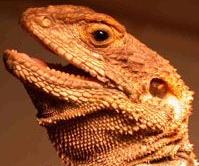Agama - Golden
Short Toed Agama, Clown Agama, Painted Agama, Painted Dragon Scientific Name: Laudakia stellio brachydactyla
Mon, 28th April, 2025 - 9:50 am GMT
Sponsor Ads:

Alternative Name
Short Toed Agama, Clown Agama, Painted Agama, Painted Dragon Scientific Name: Laudakia stellio brachydactylaBasic Info
The Golden Agama is an average sized Agama. They can reach 30 centimeters (one foot) in length at maturity. The more arid their surroundings the larger the Golden Agama gets. The Golden Agama is quite pretty and its brownis -beige scales have some golden to orange highlights. They also have darker brown markings on their backs, legs and tails. The darker markings on the tail often appear as stripes. They have powerful legs, which are quite suited for climbing. Their legs are also quite distinctive due to the presence of beautiful scaling. Each of their fingers possesses long, sharp claws. Their tails are often described as spiny. The Golden Agama may be best separated from some other agamas by its triangularly shaped head and distinctive neck.
Health
Breeding Female Golden Agamas lay a clutch of eggs in June. Clutch sizes will usually range from six to eight eggs. These eggs will incubate for several months and hatch sometime between August and September.Habitat
Found throughout the Middle East and Africa including Egypt, Israel, Saudi Arabia, and the Sinai Desert. They may also be seen in the Greek Islands.Behavior
The Golden Agama is called many different names including "Clown Agama," "Painted Agama," "Short Toed Agama," and "Painted Dragon". The Golden Agama is one of several subspecies of Laudakia stellio. There is some debate as to the exact number of subspecies, however, most of the research indicates that there are five accepted subspecies. All of the subspecies seem to prefer sandy habitats. In the wild they are commonly seen in trees, on rocks and walls, and hiding in crevices. They are generally timid, and will run for cover when startled. Males, however, can be territorial; and when they are in a defensive posture, they will chase opponents while shaking their heads. The Golden Agama is diurnal and is generally described as arboreal, though it will often make its home on rocks. In its native environment this lizard is relatively common and does not seem to be endangered. They are also fairly popular in the pet trade. The Golden Agama is reported to become accustomed to handling fairly easily, and they are generally not as aggressive as some other types of agama. Like many other animals, they usually do not like being approached quickly because they perceive this as threatening.Origin
Middle EastHistory
There seems to be some debate as to where the Pyramid Agama makes its home. Some of the debate may be due to the confusion over the number of subspecies of Laudakia stellio. Most of the research suggests this subspecies is found throughout the Middle East and Africa including Egypt, Israel, Saudi Arabia, and the Sinai Desert. They may also be seen in the Greek Islands. Since its identification, there seems to have been some debate over the correct naming of its genus. They were originally classified as Agama stellio, though today they are more commonly seen as Laudakia stellio.Common Foods
The Golden Agama is an insectivore that commonly feeds on insects such as beetles, crickets, and spiders in the wild. In captivity they should also be given a diet of insects.They are reported to prefer large insects and flying ants. They have also beenSponsor Ads:
First secure an independent income, then practice virtue. -- Unknown
Agama - Golden
Coded by: BGID® | ALL RIGHTS RESERVED Copyright © 2000-2025
Disclaimer | Privacy | Report Errors / Contact | Credits








 President of the United States of America - Real Estate mogul, Pageant owner and now one of the most controversial men in political history.
President of the United States of America - Real Estate mogul, Pageant owner and now one of the most controversial men in political history.  Politician, US Vice President and President of the USA - Joseph Robinette Biden Jr.
Politician, US Vice President and President of the USA - Joseph Robinette Biden Jr.  versus
versus  Russia: 'The Evil Empire'? Are they all that bad or is it just the USA trying to portray Russia as bad because they are a world power with land bigger and a society very different from the USA ideal?
Russia: 'The Evil Empire'? Are they all that bad or is it just the USA trying to portray Russia as bad because they are a world power with land bigger and a society very different from the USA ideal?  Global warming has been in and out as the "latest" hot topic for many years. It is, according to modern scientists, the result of man-made industrial pollutants, clearing forested areas, agriculture, etc. But now they are thinking it started way before the Industrial Revolution...
Global warming has been in and out as the "latest" hot topic for many years. It is, according to modern scientists, the result of man-made industrial pollutants, clearing forested areas, agriculture, etc. But now they are thinking it started way before the Industrial Revolution... 
 Corona virus
Corona virus 
 Users with wide screen monitors can benefit from more content on every page.
Users with wide screen monitors can benefit from more content on every page.